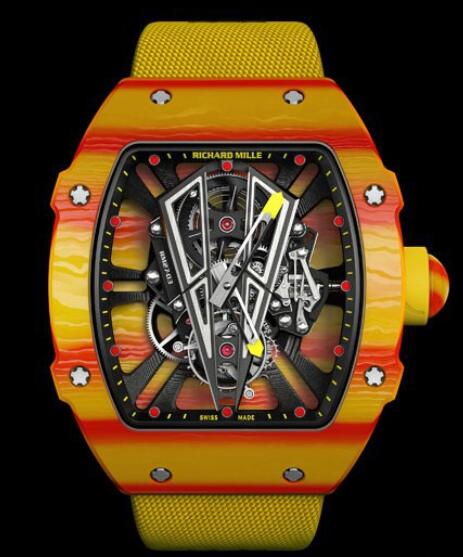
Richard Mille RM 27-03 Rafael Nadal watch with tourbillon can withstand a pressure of 10,000 G
As a stubborn full-time watch enthusiast, I find that even when I see a complicated watch for the first time, I can recognize its features and functions with great certainty, no matter how niche or strange they are. One brand that still surprised me very much is Richard Mille. He showed off their Richard Mille RM 27-03 Rafael Nadal “Tourbillon Shock Resistance” just before the French Open today. This is the latest and strangest “Rafa” will launch. Richard Mille was shot through time and space with his powerful forehand-most likely on his way to win another French Open (French Open) championship.
Specifically, the first thing that confused me with this new RM027 is the super villain’s logo style, the sporty V-shaped structural elements… Then, the second is the most technical data item that jumps out of the usually long list. Advanced technology: 10,000 g’s (in units of g-force). If you, like me, think that these two highly atypical horological things are connected in some way, then you are on the right track.
Although I admit that I am not a physicist, I can still safely say that 10,000 g is a hell of a lot of g-fighter pilots wearing crazy g-suits and the like can withstand about 0.1%. Now, to clarify-I am here to call on the Wikipedia captain to ensure that this interpretation is correct-“g-force (g comes from gravity) is a measure of the type of acceleration that causes weight perception.”
To give a real life example: when a pilot really challenges his plane and his own limits (the plane actually lasts much longer than the pilot) and he pulls 10 g, it means he feels his body “Heavy” 10 times the actual effect. When a Formula One driver corners with a weight of 3 grams, the 2 kg (5 lb) helmet on his head feels that it weighs three times as much—and so on. best replica watch site
Needless to say, to play 10,000 grams, we have to scale down a lot-to the scale of the watch and its incredibly small but powerful components. When developing and fine-tuning the Richard Mille RM 27-03 Rafael Nadal “Tourbillon Shock Resistance”, Richard Mille’s engineers used the so-called “pendulum shock device”-although some watch manufacturers have such a device, it is still A rare and very intense method for testing the durability of luxury watches.
The pendulum test device operates according to the instructions on the cover: it has a hammer-like pendulum that can be released from a set angle, which in turn determines the force it will apply to the watch. Richard Mille said that they have tested the RM 27-03 sapphire crystal facing the pendulum, and the 9 o’clock position of the case and the side of the crown are the points of impact. Then the watch will be ejected into the net-I think the “Let’s find a million-dollar prototype on the floor” game will soon become boring.
All of this is because, as Richard Mille explained, the energy generated by the vibration of the tennis racket on the ball is directly transmitted to the watch, just like the acceleration and acceleration generated by the many arm gestures made by the players during the game. Deceleration is the same. In addition, “According to the measurement results recorded by the Swiss Microtechnology Laboratory, the watch absorbs approximately 60 grams of linear acceleration during the serve of an amateur tennis player. It is easy to believe that considering the strength of Rafa and his fierce game style, he The resulting linear acceleration can easily exceed 100 grams.”
Obviously, this goal, in fact, all previous RM027 models are to prove that a high-tech version of a mechanical movement equipped with a tourbillon, if properly designed, can withstand extreme shocks-and, on the other hand, remind everyone of Richard. Miller (Richard Mille) has not given up maintaining its position as the leader of the crazy cool (and crazy expensive) high-tech watchmaking industry.
Richard Mille RM 27-03 achieves extraordinary durability through a new design in which the case and movement are constructed as a single unit. The case is TPT quartz, connected to a carbon TPT one-piece base plate, on which a grade 5 titanium bridge and reinforcement materials are installed. When we discuss the predecessor RM 27-02 of this piece here, we introduced the TPT quartz case technology.
Although the above-mentioned TPT materials are very strong and light, Richard Mille had to significantly improve the tolerance settings for movement manufacturing and assembly. After visiting various manufacturers and talking with their engineers and designers, I know that most watch movements have a minimum tolerance of 5 microns—one thousandth of a millimeter. This applies to the trickiest part that requires maximum precision, namely jewellery drilling: when two plates overlap each other and fall on opposite ends of the tolerance range, they are extremely fragile and the small pinion wheels are more likely to break on impact — —This is why the number of 5 microns is set.
Now, the tourbillon of the RM 27-03 and its parts-the weakest part, which first shows its effect under strong impact-is now carefully crafted with an incredibly tight tolerance of only 1 micron. One. I think they found that they could produce parts with such close tolerances, but with five times the margin, they still met all their previous expectations without having to discard most of the carefully crafted components.
The precision of parts manufacturing is five times higher than before-considering the micro-scale of the things we are talking about, an increase of 20% or 40% would be impressive, but to reduce the tolerance directly to one-fifth, this is all fake Richard Mille The level of engineering that no one cares about…Although it is insignificantly insignificant, it is also impressive.